.
8.08.2015
How the rubber-duck comet got its shape
Two pieces of rock became one, but the details are still up for debate.
.
A year after the Rosetta space mission went into orbit around a comet shaped like a rubber duck, scientists say that they have worked out how the dusty iceball got its shape — although they haven't ironed out every detail.
The comet 67P/Churyumov–Gerasimenko probably formed from two distinct pieces — a small head on a large body — rather than through the erosion of a single body into a duck shape, according to an analysis to be published in Astronomy and Astrophysics and available at the arXiv preprint server1.
How the two parts came together is still up for debate. But the paper suggests that the pieces are probably fragments from a once-larger comet that was smashed apart by a collision. Its alternative hypothesis is a gentler story: two small proto-comets, formed a few million years after the Solar System arose, joined together.
.
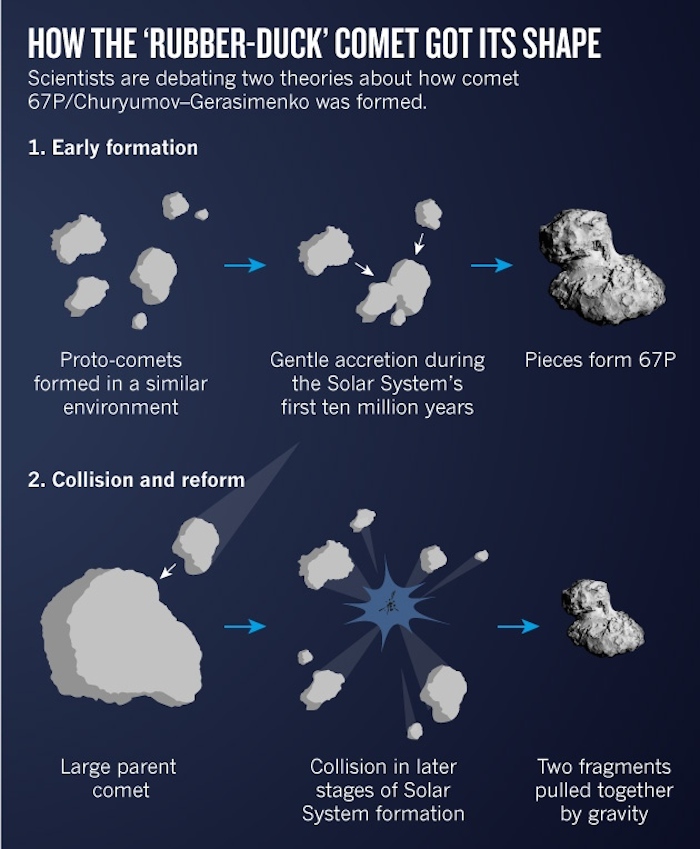
“We have a lot of data showing that the comet is likely to be made of two bodies. The big question is how these two bodies came together, and we don’t know yet,” says Jean-Baptiste Vincent, a planetary scientist at the Max Planck Institute for Solar System Research in Göttingen, Germany, who was not involved with the paper.
Tales from the crib
The tale behind the comet's duck-like shape is not merely a 'Just So' story. It could have implications for the evolution of the Solar System, says Simone Marchi, a planetary scientist at the Southwest Research Institute in Boulder, Colorado, one of the study's authors. In their paper, Marchi's team show that, given what scientists assume about the early Solar System, it would have been fraught with collisions — and the environment around comet 67/P is unlikely to have been an exception. So if 67/P grew from two small proto-comets without experiencing such a collision, this could hint that assumptions about early Solar System conditions are wrong.
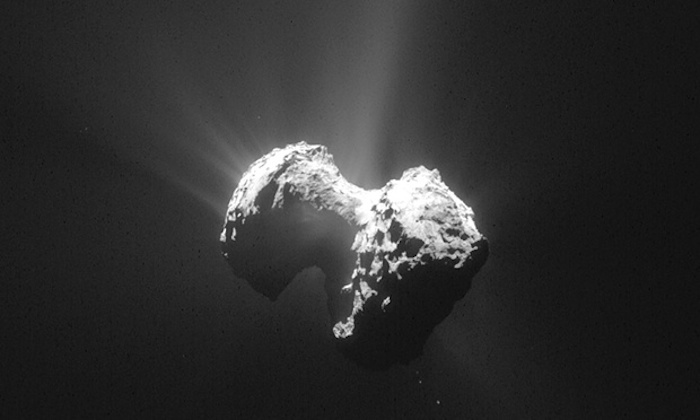
“The scenarios are two radically different pathways that would imply a radically different structure of the Solar System,” Marchi says.
It seems clear that the comet is composed of two separate parts. Terrace-like features on each cometary lobe — as imaged by the Rosetta orbiter — line up within the head or the body, but do not match up in orientation across the two pieces, as they would if the comet had been eroded from one larger object. A set of near-parallel cracks on one region of the comet's head are best explained by the coming-together of two comet pieces, say the authors. And an earlier study2 found it very implausible that one large comet could have been eroded into a duck-like shape by sunlight burning gas and dust away.
The comet’s two lobes are fairly similar in composition, which suggests that they probably formed in the same environment. That fits both of the two-body scenarios, but given the likelihood of collisions, Marchi’s team argues for the hypothesis that the two parts are fragments from a once-larger comet. However, evidence from the comet itself could yet favour the idea that two proto-comets joined up, says Vincent.
A comet whose parent body was once subject to a collision, for instance, should be compacted and show fewer voids in its interior than would a pristine comet, he says. “We’re looking at our data now and trying to see which model is supported.”
Quelle: nature
-
Update: 9.08.2015
.
Rosetta könnte dramatische Bilder liefern wenn 67P den Perihel seines Umlaufhöhepunkt erreicht - und droht zu zerbrechen
.

European scientists are preparing to celebrate an unusual midsummer festival – on a comet that is currently 165 million kilometres from Earth. The comet, 67P/Churyumov–Gerasimenko, is set to reach the closest point to the Sun in its 6.5-year orbit on Thursday and Europe’s robot probe Rosetta is poised to provide scientists with a ringside view.
The spaceship has already been in orbit around Comet 67P for a year and has studied dust and gas as they have started to erupt from its surface as it has approached the Sun. On Thursday, when the comet reaches perihelion, its closest point to the Sun, that activity will reach its peak.
“Perihelion is an important milestone in any comet’s calendar, and even more so for the Rosetta mission because this will be the first time a spacecraft has been following a comet from close quarters as it moves through this phase of its journey around the solar system,” said Matt Taylor, the European Space Agency’s Rosetta project scientist.
Comets are made of the detritus of the primordial solar system that formed around the Sun more than 4.5bn years ago. When a comet gets close to the Sun, it produces streams of sublimated ice, dust and gas that form a fuzzy atmosphere known as a coma and a spectacular tail which can stretch for millions of miles.
If this takes place near Earth, it can make a spectacular sight – as comet Hale-Bopp did in 1997. However, Comet 67P is currently so far away from our world that it can only be observed through a telescope.
By contrast, Rosetta and its little lander Philae – which were launched together in 2004 – have managed to get up close and personal with 67P and have made some spectacular discoveries, including the presence of a rich brew of 14 organic chemicals including methyl isocyanate, acetone, propionaldehyde and acetamide in the comet’s soil.
This discovery gives support to the idea that comets, crashing on Earth, might have played a key role in providing materials that led to the appearance of rudimentary life on our world. Because of awkward landing conditions, however, space engineers are unsure if Philae will be able to provide any more information for them.Rosetta has also discovered that the interior of 67P is extraordinarily light. At least 75% of it is empty space. Scientists speculate that much of its interior material may have been vented into space as the comet has warmed up during previous close encounters with the Sun.

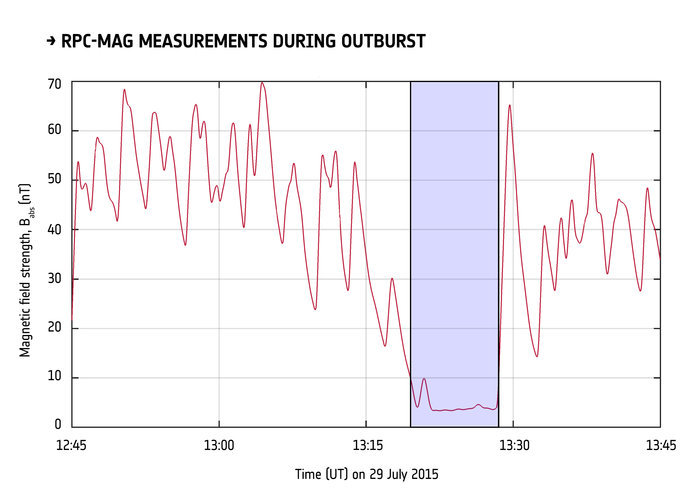
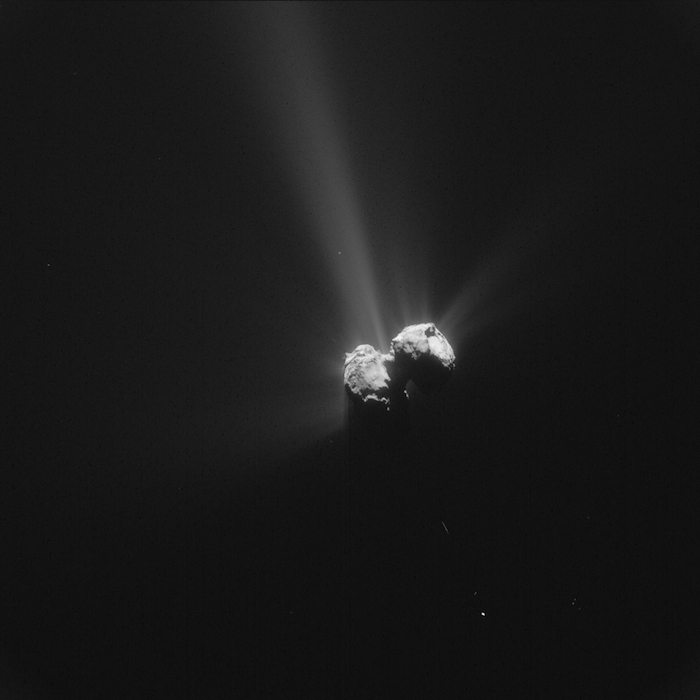
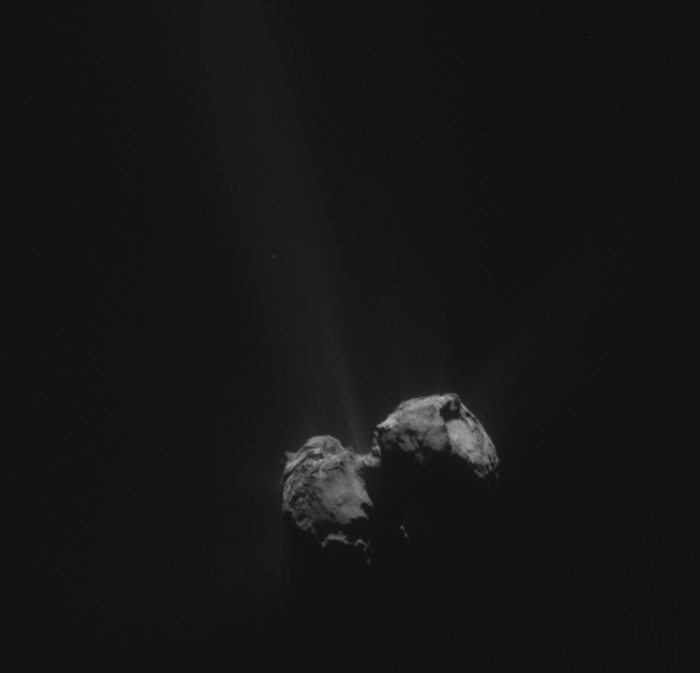
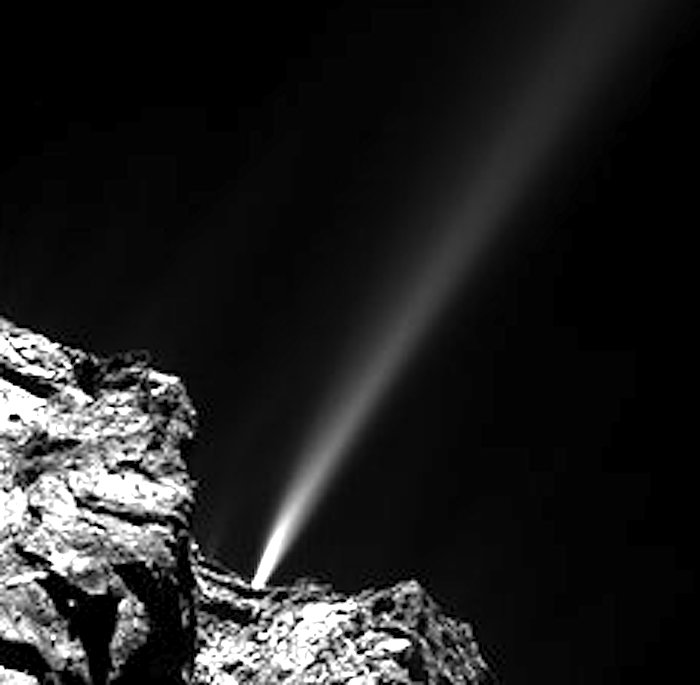
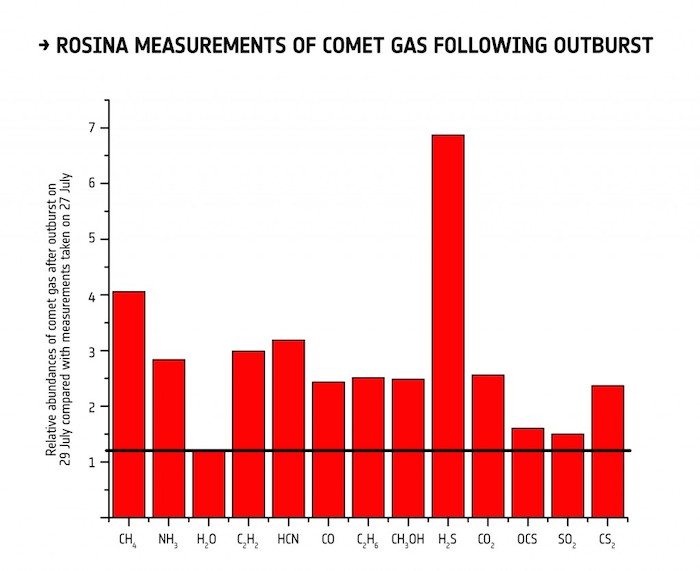
“When a comet is closest to the Sun, the maximum amount of heat percolates through its dusty surface and stimulates activity,” said Mark McCaughrean, a senior scientist at the European Space Agency.
As a result, ice, carbon dioxide and carbon monoxide below the surface evaporate and vent into space, carrying with them dust that covers the comet. “Often this produces deep pits into which surface ice and dust collapse, creating sinkholes all over the comet,” added McCaughrean.
After perihelion, 67P will swing away from the Sun and start to cool. Rosetta will follow it for another year to study changes that took place on its surface. These could include the appearance of many new sinkholes.
“Our problem at this stage is getting close to 67P,” said McCaughrean. “When it is at its most active, the comet produces a great deal of dust, and those particles confuse Rosetta’s onboard star tracker. It uses the positions of stars to align itself, but gets confused when lots of new pinpricks of light appear.
We are – for the first time – getting an unprecedented view of a comet as it sweeps round the Sun
Mark McCaughrean, Esa
“As a result, we have to keep Rosetta relatively high above the comet, which means we cannot study it in the detail that we might have wished for. On the other hand, we are – for the first time – getting an unprecedented view of a comet as it sweeps round the Sun.”
In addition, there is a prospect that a far more spectacular event could occur on 67P. The comet is shaped like a huge rubber duck and Rosetta has found that the neck has developed a 500-metre fracture. This could widen and deepen as more and more material is vented from its interior and could cause the comet to split in two.
Photographs of the huge object splintering apart would be some of the most dramatic images ever recorded by space scientists.
In the end, after another year of tracking 67P, ESA space engineers will allow the craft to spiral in on 67P and gently crashland on it. “After the summer of 2016, communications with the probe will start to break up, so before that happens we will spiral it very slowly down on to the surface of 67P, going down from 20 to 10 to 5 to 2 kilometres before landing it gently. We may not be able to keep our communications link at the very end, but it will be worth trying to get one last, really close-up view of the comet.”
Quelle: the guardian
.
Update: 11.08.2015
.
Comet´s firework display ahead of perihelion

In the approach to perihelion over the past few weeks, Rosetta has been witnessing growing activity from Comet 67P/Churyumov–Gerasimenko, with one dramatic outburst event proving so powerful that it even pushed away the incoming solar wind.
The comet reaches perihelion on Thursday, the moment in its 6.5-year orbit when it is closest to the Sun. In recent months, the increasing solar energy has been warming the comet’s frozen ices, turning them to gas, which pours out into space, dragging dust along with it.
The period around perihelion is scientifically very important, as the intensity of the sunlight increases and parts of the comet previously cast in years of darkness are flooded with sunlight.
Although the comet’s general activity is expected to peak in the weeks following perihelion, much as the hottest days of summer usually come after the longest days, sudden and unpredictable outbursts can occur at any time – as already seen earlier in the mission.
.

Discovery of diamagnetic cavity
.
On 29 July, Rosetta observed the most dramatic outburst yet, registered by several of its instruments from their vantage point 186 km from the comet. They imaged the outburst erupting from the nucleus, witnessed a change in the structure and composition of the gaseous coma environment surrounding Rosetta, and detected increased levels of dust impacts.
Perhaps most surprisingly, Rosetta found that the outburst had pushed away the solar wind magnetic field from around the nucleus.
A sequence of images taken by Rosetta’s scientific camera OSIRIS show the sudden onset of a well-defined jet-like feature emerging from the side of the comet’s neck, in the Anuket region. It was first seen in an image taken at 13:24 GMT, but not in an image taken 18 minutes earlier, and has faded significantly in an image captured 18 minutes later. The camera team estimates the material in the jet to be travelling at 10 m/s at least, and perhaps much faster.
“This is the brightest jet we’ve seen so far,” comments Carsten Güttler, OSIRIS team member at the Max Planck Institute for Solar System Research in Göttingen, Germany.
“Usually, the jets are quite faint compared to the nucleus and we need to stretch the contrast of the images to make them visible – but this one is brighter than the nucleus.”
Quelle: ESA
-
Update: 12.08.2015
.
COMETWATCH 6 AUGUST
Today's CometWatch entry is an image of Comet 67P/Churyumov-Gerasimenko taken on 6 August 2015, exactly a year to the day of Rosetta's historic rendezvous. The image was taken 261 km from the comet centre.
.

Comet 67P/C-G on 6 August (with contrasts enhanced) from a distance of 261 km. With a scale of 22.3 m/pixel, the image measures 22.8 km across. Credits: ESA/Rosetta/NAVCAM – CC BY-SA IGO 3.0
.
Currently, the comet is around 186 million km from the Sun, and it will reach perihelion – the closest point to the Sun along its orbit – next Thursday. This image shows an intense comet activity, with prominent outflows and jets of material and the unlit patches of the nucleus standing out as a silhouette against the overall bright background.
Due to the increased concentration of gas and dust over the last few months, Rosetta is now studying the comet from safer distances, and is currently operating some 300 km out.
In the spirit of celebrating Rosetta's first year at the comet, we tried to compare this image with one that was taken exactly one year ago, on rendezvous day, 6 August 2014. The result was posted as ESA's Space Science Image of the Week.
The original 1024 x 1024 pixel image for today’s CometWatch entry is provided below:
.

...
COMET’S FIREWORK DISPLAY AHEAD OF PERIHELION
.
In the approach to perihelion over the past few weeks, Rosetta has been witnessing growing activity from Comet 67P/Churyumov–Gerasimenko, with one dramatic outburst event proving so powerful that it even pushed away the incoming solar wind.
The comet reaches perihelion on Thursday, the moment in its 6.5-year orbit when it is closest to the Sun. In recent months, the increasing solar energy has been warming the comet’s frozen ices, turning them to gas, which pours out into space, dragging dust along with it.
The period around perihelion is scientifically very important, as the intensity of the sunlight increases and parts of the comet previously cast in years of darkness are flooded with sunlight.
Although the comet’s general activity is expected to peak in the weeks following perihelion, much as the hottest days of summer usually come after the longest days, sudden and unpredictable outbursts can occur at any time – as already seen earlier in the mission.
.

A short-lived outburst from Comet 67P/Churyumov–Gerasimenko was captured by Rosetta’s OSIRIS narrow-angle camera on 29 July 2015. The image at left was taken at 13:06 GMT and does not show any visible signs of the jet. It is very strong in the middle image captured at 13:24 GMT. Residual traces of activity are only very faintly visible in the final image taken at 13:42 GMT. Credits: ESA/Rosetta/MPS for OSIRIS Team MPS/UPD/LAM/IAA/SSO/INTA/UPM/DASP/IDA
.
On 29 July, Rosetta observed the most dramatic outburst yet, registered by several of its instruments from their vantage point 186 km from the comet. They imaged the outburst erupting from the nucleus, witnessed a change in the structure and composition of the gaseous coma environment surrounding Rosetta, and detected increased levels of dust impacts.
Perhaps most surprisingly, Rosetta found that the outburst had pushed away the solar wind magnetic field from around the nucleus.
A sequence of images taken by Rosetta’s scientific camera OSIRIS show the sudden onset of a well-defined jet-like feature emerging from the side of the comet’s neck, in the Anuket region. It was first seen in an image taken at 13:24 GMT, but not in an image taken 18 minutes earlier, and has faded significantly in an image captured 18 minutes later. The camera team estimates the material in the jet to be travelling at 10 m/s at least, and perhaps much faster.
“This is the brightest jet we’ve seen so far,” comments Carsten Güttler, OSIRIS team member at the Max Planck Institute for Solar System Research in Göttingen, Germany.
“Usually, the jets are quite faint compared to the nucleus and we need to stretch the contrast of the images to make them visible – but this one is brighter than the nucleus.”
.

During an outburst of gas and dust from Comet 67P/Churyumov–Gerasimenko on 29 July 2015, Rosetta’s ROSINA instrument detected a change in the composition of gases compared with previous days.
The graph shows the relative abundances of various gases after the outburst, compared with measurements two days earlier (water vapour is indicated by the black line).
Credits: ESA/Rosetta/ROSINA/UBern/ BIRA/LATMOS/LMM/IRAP/MPS/SwRI/TUB/UMich
Soon afterwards, the comet pressure sensor of ROSINA detected clear indications of changes in the structure of the coma, while its mass spectrometer recorded changes in the composition of outpouring gases.
For example, compared to measurements made two days earlier, the amount of carbon dioxide increased by a factor of two, methane by four, and hydrogen sulphide by seven, while the amount of water stayed almost constant.
“This first ‘quick look’ at our measurements after the outburst is fascinating,” says Kathrin Altwegg, ROSINA principal investigator at the University of Bern. “We also see hints of heavy organic material after the outburst that might be related to the ejected dust.
“But while it is tempting to think that we are detecting material that may have been freed from beneath the comet's surface, it is too early to say for certain that this is the case.”
Meanwhile, about 14 hours after the outburst, GIADA was detecting dust hits at rates of 30 per day, compared with just 1–3 per day earlier in July. A peak of 70 hits was recorded in one 4-hour period on 1 August, indicating that the outburst continued to have a significant effect on the dust environment for the following few days.
“It was not only the abundance of the particles, but also their speeds measured by GIADA that told us something ‘different’ was happening: the average particle speed increased from 8 m/s to about 20 m/s, with peaks at 30 m/s – it was quite a dust party!” says Alessandra Rotundi, principal investigator at the ‘Parthenope’ University of Naples, Italy.
Perhaps the most striking result is that the outburst was so intense that it actually managed to push the solar wind away from the nucleus for a few minutes – a unique observation made by the Rosetta Plasma Consortium’s magnetometer.
The solar wind is the constant stream of electrically charged particles that flows out from the Sun, carrying its magnetic field out into the Solar System. Earlier measurements made by Rosetta and Philae had already shown that the comet is not magnetised, so the only source for the magnetic field measured around it is the solar wind.
But it doesn’t flow past unimpeded. Because the comet is spewing out gas, the incoming solar wind is slowed to a standstill where it encounters that gas and a pressure balance is reached.
“The solar wind magnetic field starts to pile up, like a traffic jam, and eventually stops moving towards the comet nucleus, creating a magnetic field-free region on the Sun-facing side of the comet called a ‘diamagnetic cavity’,” explains Charlotte Götz, magnetometer team member at the Institute for Geophysics and extraterrestrial Physics in Braunschweig, Germany.
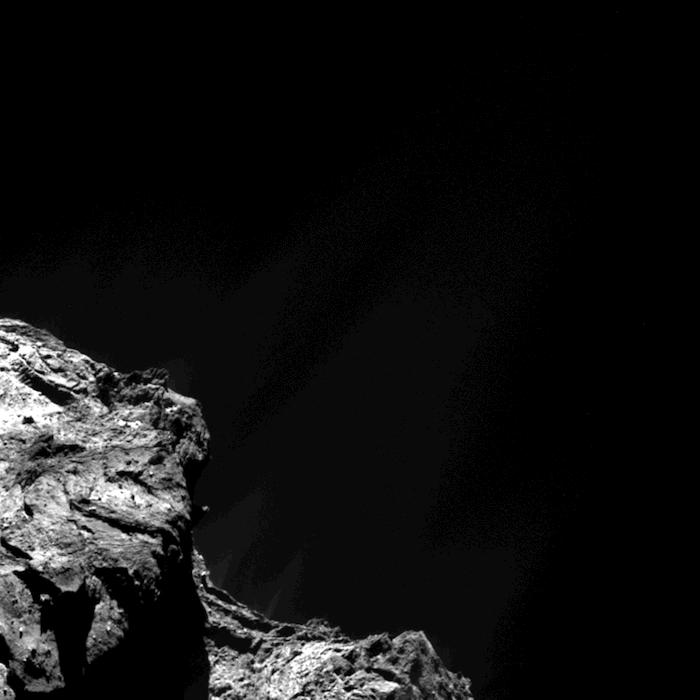
Diamagnetic cavities provide fundamental information on how a comet interacts with the solar wind, but the only previous detection of one associated with a comet was made at about 4000 km from Comet Halley as ESA’s Giotto flew past in 1986.
Rosetta’s comet is much less active than Halley, so scientists expected to find a much smaller cavity around it, up to a few tens of kilometres at most, and prior to 29 July, had not observed any sign of one.
But, following the outburst on that day, the magnetometer detected a diamagnetic cavity extending out at least 186 km from the nucleu. This was likely created by the outburst of gas, which increased the neutral gas flux in the comet’s coma, forcing the solar wind to ‘stop’ further away from the comet and thus pushing the cavity boundary outwards beyond where Rosetta was flying at the time.
“Finding a magnetic field-free region anywhere in the Solar System is really hard, but here we’ve had it served to us on a silver platter – this is a really exciting result for us,” adds Charlotte.
“We’ve been moving Rosetta out to distances of up to 300 km in recent weeks to avoid problems with navigation caused by dust, and we had considered that the diamagnetic cavity was out of our grasp for the time being. But it seems that the comet has helped us by bringing the cavity to Rosetta,” says Matt Taylor, Rosetta Project Scientist.
“This is a fantastic multi-instrument event which will take time to analyse, but highlights the exciting times we’re experiencing at the comet in this ‘hot’ perihelion phase.”
Quelle: ESA
.
Update: 18.50 MESZ
.
Rosetta Comet Outburst Captured
.

A short-lived outburst from comet 67P/Churyumov–Gerasimenko was captured by Rosetta’s OSIRIS narrow-angle camera on July 29, 2015. The image at left was taken at 13:06 Greenwich Mean Time (GMT) (6:06 a.m. PDT), and does not show any visible signs of the jet. It is very strong in the middle image captured at 13:24 GMT (6:24 a.m. PDT). Residual traces of activity are only very faintly visible in the final image taken at 13:42 GMT (6:42 a.m. PDT). The images were taken from a distance of 116 miles (186 kilometers) from the center of the comet. The jet is estimated to have a minimum speed of 33 feet per second (10 meters per second) and originates from a location on the comet’s neck.
Credits: ESA/Rosetta/MPS
The European Space Agency's Rosetta spacecraft has been witnessing growing activity from comet 67P/Churyumov–Gerasimenko as the comet approaches perihelion (its closest point to the sun during its orbit). On July 29, while the spacecraft orbited at a distance of 116 miles (186 kilometers) from the comet, it observed the most dramatic outburst to date. Early science results collected during the outburst came from several instruments aboard Rosetta, including the Double Focusing Mass Spectrometer (DFMS), which uses NASA-built electronics. The DFMS is part of the spacecraft's Rosetta Orbiter Spectrometer for Ion and Neutral Analysis (ROSINA) instrument.
When the outburst occurred, the spectrometer recorded dramatic changes in the composition of outpouring gases from the comet when compared to measurements made two days earlier. As a result of the outburst, the amount of carbon dioxide increased by a factor of two, methane by four, and hydrogen sulfide by seven, while the amount of water stayed almost constant.
"This first quick look at our measurements after the outburst is fascinating," said Kathrin Altwegg, principal investigator for the ROSINA instrument from the University of Bern, Switzerland. "We also see hints of heavy organic material after the outburst that might be related to the ejected dust.
"But while it is tempting to think that we are detecting material that may have been freed from beneath the comet's surface, it is too early to say for certain that this is the case."
A sequence of images taken by Rosetta’s scientific camera OSIRIS shows the sudden onset of a well-defined, jet-like feature emerging from the side of the comet’s neck. The jet, the brightest seen to date, was first recorded in an image taken at 6:24 a.m. PDT (9:24 a.m. EDT, 13:24 GMT) on July 29, but not in an image taken 18 minutes earlier. The jet then faded significantly in an image captured 18 minutes later. The OSIRIS camera team estimates the material in the jet was traveling at 33 feet per second (10 meters per second), at least.
On Thursday, Aug. 13, the comet and Rosetta will be 116 million miles (186 million kilometers) from the sun -- the closest to the sun they will be in their 6.5-year orbit. In recent months, the increasing solar energy has been warming the comet’s frozen ices -- turning them to gas -- which pours out into space, dragging dust along with it. The period around perihelion is scientifically very important, as the intensity of the sunlight increases and parts of the comet previously cast in years of darkness are flooded with sunlight. The comet’s general activity is expected to peak in the weeks following perihelion.
Comets are time capsules containing primitive material left over from the epoch when the sun and its planets formed. Rosetta's lander, Philae, obtained the first images taken from a comet's surface and will provide analysis of the comet's possible primordial composition. Rosetta is the first spacecraft to witness at close proximity how a comet changes as it is subjected to the increasing intensity of the sun's radiation. Observations are helping scientists learn more about the origin and evolution of our solar system and the role comets may have played in seeding Earth with water, and perhaps even life.
Rosetta is a a European Space Agency mission with contributions from its member states and NASA. The Jet Propulsion Laboratory, Pasadena, California, a division of the California Institute of Technology in Pasadena, manages the U.S. contribution of the Rosetta mission for NASA's Science Mission Directorate in Washington. JPL also built the MIRO instrument and hosts its principal investigator, Samuel Gulkis. The Southwest Research Institute (San Antonio and Boulder) developed the Rosetta orbiter's IES and Alice instruments, and hosts their principal investigators, James Burch (IES) and Alan Stern (Alice).
Quelle: NASA
4453 Views
